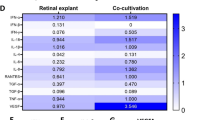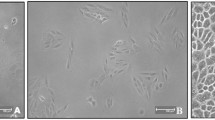Abstract
Background
Retinal pigment epithelium (RPE) cells produce neurotrophic factors that rescue photoreceptors from degeneration. Previously, we showed that conditioned medium (CM) from fetal vs adult RPE cells resulted in significantly better porcine retinal preservation, and possessed significantly higher levels of hepatocyte growth factor (HGF) and pigment epithelium-derived factor (PEDF). This study aimed to further describe the effects of human fetal RPE-CM on porcine and aged human retina, and to characterize its effects biochemically.
Methods
RPE-CM was harvested from passage-2 fetal RPE, 7 days after passage, 24-hours after exposure to basal medium. After culture in RPE-CM, porcine retinal morphology was assessed with confocal microscopy. The effects of RPE-CM on porcine and aged human retina survival were assessed by cytotoxicity and apoptosis biochemical assays. To characterize RPE-CM biochemically, effects of heating, digesting with proteinase-K, dilution, concentration, and fractionation were tested. Recombinant proteins and neutralizing antibodies were used to identify proteins that might contribute to the salutary effects of RPE-CM on porcine retina.
Results
Culturing porcine retina in RPE-CM significantly preserved outer nuclear layer width and the number of nuclei in cross-section, and significantly decreased photoreceptor axon retraction. RPE-CM decreased porcine retinal death by 17–34 % (p < 0.05) compared to basal medium. Human retina from age-related macular degeneration (AMD) and non-AMD donors responded similarly after culture in RPE-CM. Heating, proteinase-K digestion, and dilution significantly diminished RPE-CM-mediated preservation of porcine retina, whereas concentrating RPE-CM significantly enhanced its preservation of porcine retina. Molecular cut filtration identified retina-preserving activity in the 3–100 kDa filtrate. PEDF or HGF at 90 % receptor occupancy significantly improved retinal preservation over 48 h of culture compared to basal medium. Neutralizing PEDF in RPE-CM decreased its ability to reduce retinal apoptosis by 23–27 % (p < 0.05).
Conclusion
RPE-CM reduced biochemically and histologically measured degeneration in porcine retinae. This effect was concentration-dependent, and can be attributed to a protein component(s) in a 3–100 kDa molecular cut fraction. Human retina (including non-AMD and AMD Caucasian and non-AMD African-American) responds to culture in RPE-CM similarly to porcine retina. Receptor occupancy calculations and retinal viability data indicate that PEDF may be one of the components that contribute to retina preservation by RPE-CM.







Similar content being viewed by others

References
Sieving PA, Caruso RC, Tao W, Coleman HR, Thompson DJ, Fullmer KR, Bush RA (2006) Ciliary neurotrophic factor (CNTF) for human retinal degeneration: phase I trial of CNTF delivered by encapsulated cell intraocular implants. Proc Natl Acad Sci USA 103:3896–3901
Zarbin MA (2007) Functionalizing cell-based therapy for age-related macular degeneration. Am J Ophthalmol 143:681–682
Gullapalli VK, Sugino IK, Van Patten Y, Shah S, Zarbin MA (2005) Impaired RPE survival on aged submacular human Bruch’s membrane. Exp Eye Res 80:235–248
Binder S, Krebs I, Hilgers RD, Abri A, Stolba U, Assadoulina A, Kellner L, Stanzel BV, Jahn C, Feichtinger H (2004) Outcome of transplantation of autologous retinal pigment epithelium in age-related macular degeneration: a prospective trial. Invest Ophthalmol Vis Sci 45:4151–4160
Tezel TH, Del Priore LV, Berger AS, Kaplan HJ (2007) Adult retinal pigment epithelial transplantation in exudative age-related macular degeneration. Am J Ophthalmol 143:584–595
Peyman GA, Blinder KJ, Paris CL, Alturki W, Nelson NC Jr, Desai U (1991) A technique for retinal pigment epithelium transplantation for age-related macular degeneration secondary to extensive subfoveal scarring. Ophthalmic Surg 22:102–108
Algvere PV, Gouras P, Dafgard Kopp E (1999) Long-term outcome of RPE allografts in non-immunosuppressed patients with AMD. Eur J Ophthalmol 9:217–230
Joussen AM, Heussen FM, Joeres S, Llacer H, Prinz B, Rohrschneider K, Maaijwee KJ, van Meurs J, Kirchhof B (2006) Autologous translocation of the choroid and retinal pigment epithelium in age-related macular degeneration. Am J Ophthalmol 142:17–30
Joussen AM, Joeres S, Fawzy N, Heussen FM, Llacer H, van Meurs JC, Kirchhof B (2007) Autologous translocation of the choroid and retinal pigment epithelium in patients with geographic atrophy. Ophthalmology 114:551–560
Cayouette M, Gravel C (1997) Adenovirus-mediated gene transfer of ciliary neurotrophic factor can prevent photoreceptor degeneration in the retinal degeneration (rd) mouse. Hum Gene Ther 8:423–430
Cayouette M, Smith SB, Becerra SP, Gravel C (1999) Pigment epithelium-derived factor delays the death of photoreceptors in mouse models of inherited retinal degenerations. Neurobiol Dis 6:523–532
Chong NH, Alexander RA, Waters L, Barnett KC, Bird AC, Luthert PJ (1999) Repeated injections of a ciliary neurotrophic factor analogue leading to long-term photoreceptor survival in hereditary retinal degeneration. Invest Ophthalmol Vis Sci 40:1298–1305
Frasson M, Picaud S, Leveillard T, Simonutti M, Mohand-Said S, Dreyfus H, Hicks D, Sabel J (1999) Glial cell line-derived neurotrophic factor induces histologic and functional protection of rod photoreceptors in the rd/rd mouse. Invest Ophthalmol Vis Sci 40:2724–2734
Lenzi L, Coassin M, Lambiase A, Bonini S, Amendola T, Aloe L (2005) Effect of exogenous administration of nerve growth factor in the retina of rats with inherited retinitis pigmentosa. Vision Res 45:1491–1500
Streichert LC, Birnbach CD, Reh TA (1999) A diffusible factor from normal retinal cells promotes rod photoreceptor survival in an in vitro model of retinitis pigmentosa. J Neurobiol 39:475–490
Kolomeyer AM, Sugino IK, Zarbin MA (2011) Characterization of conditioned media collected from aged versus young human eye cups. Invest Ophthalmol Vis Sci 52:5963–5972
Kolomeyer AM, Sugino IK, Zarbin MA (2011) Characterization of conditioned media collected from cultured adult versus fetal retinal pigment epithelial cells. Invest Ophthalmol Vis Sci 52:5973–5986
Khodair MA, Zarbin MA, Townes-Anderson E (2003) Synaptic plasticity in mammalian photoreceptors prepared as sheets for retinal transplantation. Invest Ophthalmol Vis Sci 44:4976–4988
Ablonczy Z, Dahrouj M, Tang PH, Liu Y, Sambamurti K, Marmorstein AD, Crosson CE (2011) Human retinal pigment epithelium cells as functional models for the RPE in vivo. Invest Ophthalmol Vis Sci 52:8614–8620
Steinberg RH (1985) Interactions between the retinal pigment epithelium and the neural retina. Doc Ophthalmol 60:327–346
Beauchemin ML (1974) The fine structure of the pig’s retina. Albrecht Von Graefes Arch Klin Exp Ophthalmol 190:27–45
Beltran WA, Rohrer H, Aguirre GD (2005) Immunolocalization of ciliary neurotrophic factor receptor alpha (CNTFRalpha) in mammalian photoreceptor cells. Mol Vis 11:232–244
Bonnet D, Garcia M, Vecino E, Lorentz JG, Sahel J, Hicks D (2004) Brain-derived neurotrophic factor signalling in adult pig retinal ganglion cell neurite regeneration in vitro. Brain Res 1007:142–151
Braekevelt CR (1983) Fine structure of the retinal rods and cones in the domestic pig. Graefes Arch Clin Exp Ophthalmol 220:273–278
Xiao M, McLeod D, Cranley J, Williams G, Boulton M (1999) Growth factor staining patterns in the pig retina following retinal laser photocoagulation. Br J Ophthalmol 83:728–736
Brocco MA, Panzetta P (1999) Survival and process regrowth of purified chick retinal ganglion cells cultured in a growth factor lacking medium at low density. Modulation by extracellular matrix proteins. Brain Res Dev Brain Res 118:23–32
Martinez-Morales JR, Marti E, Frade JM, Rodriguez-Tebar A (1995) Developmentally regulated vitronectin influences cell differentiation, neuron survival and process outgrowth in the developing chicken retina. Neuroscience 68:245–253
Li A, Lane WS, Johnson LV, Chader GJ, Tombran-Tink J (1995) Neuron-specific enolase: a neuronal survival factor in the retinal extracellular matrix? J Neurosci 15:385–393
He PM, He S, Garner JA, Ryan SJ, Hinton DR (1998) Retinal pigment epithelial cells secrete and respond to hepatocyte growth factor. Biochem Biophys Res Commun 249:253–257
Tonges L, Ostendorf T, Lamballe F, Genestine M, Dono R, Koch JC, Bahr M, Maina F, Lingor P (2011) Hepatocyte growth factor protects retinal ganglion cells by increasing neuronal survival and axonal regeneration in vitro and in vivo. J Neurochem 117:892–903
Mekhoubad S, Bock C, de Boer AS, Kiskinis E, Meissner A, Eggan K (2012) Erosion of dosage compensation impacts human iPSC disease modeling. Cell Stem Cell 10:595–609
Acknowledgements
The authors thank Dr. Weifeng Wang for assistance with in-vitro porcine retina culture.
Support
The Janice Mitchell Vassar and Ashby John Mitchell Fellowship (MAZ), the Joseph J. and Marguerite DiSepio Retina Research Fund (MAZ), an unrestricted grant from Research to Prevent Blindness (MAZ), Research to Prevent Blindness Medical Student Fellowship (AMK), Midwest Eye Banks Student Stipend (AMK), and American Foundation for Aging Research Graduate Student Fellowship (AMK).
Conflict of interest
AM Kolomeyer, IK Sugino, MA Zarbin. U.S. patent application No. 13/420,502 “Compositions and Methods for Cell based Retinal Therapies”
Data
The authors have full control of all primary data, and agree to allow data to be reviewed upon request.
Author information
Authors and Affiliations
Corresponding author
Rights and permissions
About this article
Cite this article
Kolomeyer, A.M., Sugino, I.K. & Zarbin, M.A. Characterization of the effects of retinal pigment epithelium-conditioned media on porcine and aged human retina. Graefes Arch Clin Exp Ophthalmol 251, 1515–1528 (2013). https://doi.org/10.1007/s00417-013-2326-3
Received:
Revised:
Accepted:
Published:
Issue Date:
DOI: https://doi.org/10.1007/s00417-013-2326-3



